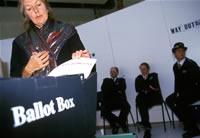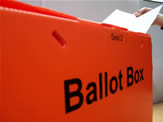Voting systems

STV - The Single Transferable Vote was used for the first time in Scotland at the local government elections which took place on 3 May 2007.
Instead of marking a cross, voters indicate their preferences on the ballot paper by ranking the candidates in order (first, second, third, etc.) and may vote in this way for as many or as few of the listed candidates as they wish.
A formula is then used to calculate who is elected for each ward. Each Council ward returns either three or four councillors to represent local people. As a further innovation, the counting for this type of election is now done electronically. This is designed to speed up the counting process and improve the accuracy of the results.
FPTP - First Past the Post voting takes place in single-member parliamentary constituencies. To vote under FPTP, the voter simply puts a cross on the ballot paper next to one candidate. The candidate with the most votes wins.
AMS - The Additional Member System elects representatives from geographic constituencies and  others from party lists under a form of proportional representation.
others from party lists under a form of proportional representation.
Essentially, electors have two votes, one for the party or individual candidate on a list and the other for a candidate in a constituency. The constituency representatives are elected under the first-past-the post system.
A Closed Party List is used for electing representatives to the European Parliament. Rather than voting in a single -member constituency for a specific candidate, electors vote only for a party in a multi-member constituency, or, as in the case of Scotland, a whole country.
Each party's list of candidates, ranked accordingly to the party's preference, is published on the ballot paper and electors may place a single cross next to their choice. All the votes are counted, and each party is allocated seats in the constituency in broadly the same proportion to the votes it has won. Those who became the party's elected representatives are those placed highest in the party's list of candidates.
Types of Elections
UK Parliamentary Elections
Members of Parliament (MP's) are elected using a First Past the Post System (FPTP). The UK Parliament currently has a fixed term 5-year life span, although in the exceptional circumstances a General Election may be called at any time within the Parliament's lifetime. In Aberdeenshire, electors vote to return MP's in the Banff and Buchan, Gordon or West Aberdeenshire and Kincardine constituencies. Those elected sit in the Westminster Parliament.
Local Government Elections
The Scottish Government is responsible for Local Government Elections in Scotland and Scottish Ministers issue rules for the way they are conducted. Elections are held to elect Councillors to 32 unitary local authorities in Scotland. Since 3 May 2007, Councillors have been elected through the Single Transferable Vote (STV) system which allows voters to express a preference for more than one candidate by ranking them in order.
Scottish Parliamentary Elections
There are currently 129 elected members in the Scottish Parliament at Holyrood, of which 73 are constituency members and 56 are list members. Scottish Parliamentary Elections use the Additional Member System (AMS) where each voter has two votes. One of these elects a constituency MSP using the first past the post system, and the other elects regional representatives from a list of political parties and individual candidates. The elections take place every four years and, depending on where you live in Aberdeenshire, you can currently vote to return a constituency MSP for either the Banffshire and Buchan Coast, Aberdeenshire East or Aberdeenshire West constituencies, as well as list MSPs for the North East Scotland Region.
European Elections
The UK is divided into twelve regions, each of which has between 3 and 10 MEPs representing the area. Aberdeenshire is part of the Scotland "region" which returned six MEPs in 2014 using a closed list system. MEPs sit in the European Parliament in Strasbourg.
Cairngorm National Park Authority Elections
Aberdeenshire Council is responsible for running elections to Ward 5 of the Cairngorm National Park Authority. Elections take place every four years on an all-postal basis.
By-Elections/Referendums
A By-Election occurs due to a vacancy caused by the death or resignation of an elected representative. It can take place during any of the standard election cycles, and is subject to the timetable for normal elections. Referendums can take place at any time.

